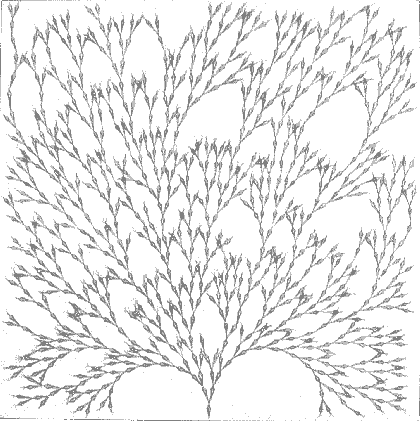B l i n d S c r i b b l e s
I started to draw seriously in the summer of 1967. It was a classic case of Freudian sublimation. My girlfriend and I were living in Cambridge, Massachusetts, on different floors of the same building. We both had roommates. One night I came home and found her in bed with one of mine. I was so angry and hurt that I moved out right away and started to pour all of my energy into drawing. I wrote back then:
"...it was like seeing for the first time. Everything was so clear and sharp and tangible. I feel the vast infinity of very small bits of matter - they are all over, for there are no holes in vision, no blanks or left-out portions, and everything is not just a total, but a group of very small individual items, like sand or atoms even.... I was so moved by this vividness & clarity that... I knew this vividness would have to be my expressive aim in art." (Diary entry, July 1967)
A few months later, I did a series of drawings inspired by television static - what you see on a TV channel when thereís no signal. Not coincidentally, this kind of image is made entirely of "very small bits." Colored dots, all the same size, filled these drawings from edge to edge.
Then I started making drawings where the whole image was built out of repeated parallel "scan lines," again inspired by television. I would move the pen along a ruler so fast that the ink skipped and broke into tiny dots and dashes. I started using a technical drafting pen like architects use (and like I still use today). Before that I had mainly used signpainting brushes, calligraphy pens and felt-tipped markers.
Over the next two years (1967-69) I developed this idea of "drawing fast enough to fragment the inkline" into a set of freehand gestures: scribbles, zig-zags, hatches and swirls. I didnít like the way these drawings looked and I threw them away. But they were fun to make so I kept at it. And I began drawing with my eyes closed, to see what actions felt right regardless of the visual result.
I had just graduated from college (1969). Drawing with my eyes shut was part of a process of unlearning what I had been taught. My teachers got me to look at my work "objectively," like a viewer. But in fact, Iím the only person whose relationship to the work is not as a viewer. It was a lie to deny that, and I felt I had to go the opposite way, toward the primacy of the experience of making the drawing.
So in late 1969/early 1970, I drew mostly with my eyes closed. Gradually my blind scribbles and zig-zags converged to a few basic gestures, and eventually to just one type of mark: an "escapement" made by putting the pen on the paper and flicking it. The split-second acceleration of the point attenuates the flow of ink so that the mark tapers, then breaks into tiny skips, and then disappears completely. It leaves a straight comet-shaped track about 1-2 cm long. No two ink marks are exactly the same, but their diversity is strictly limited.
I didnít have a rationale requiring the use of just one mark, so I tried combining the "winner" with non-gestural elements - ruled lines and ink spatters - but I dropped these experiments quickly. From the summer of 1970 onward, I used just the one mark.

A History of Ideas, 1 August 1978 (37 x 37 cm)
| Page 1 | Page 3 |